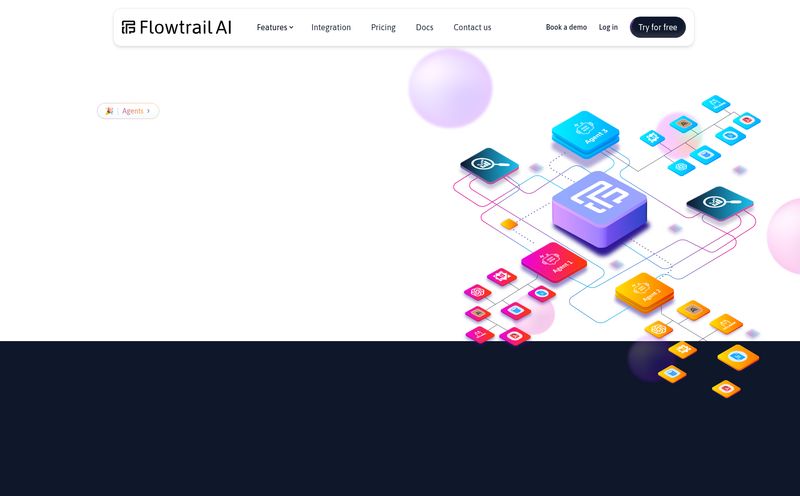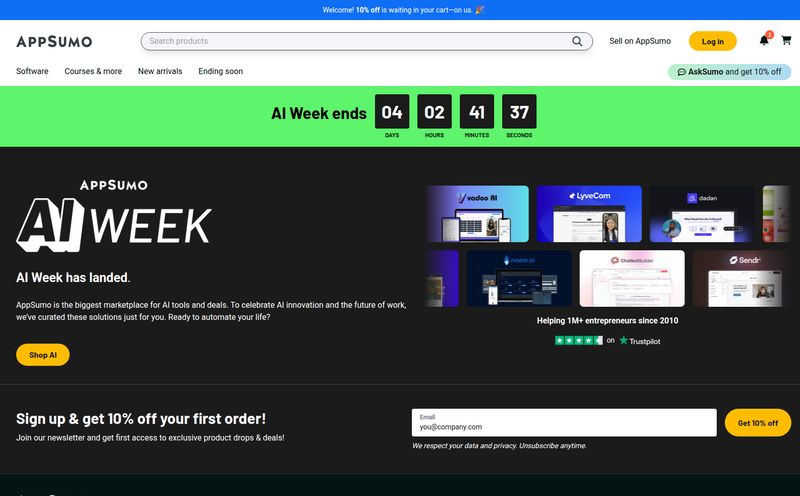If I had a dollar for every time I’ve had to type my name, email, and address into a web form, I’d probably have enough money to hire someone to... well, fill out web forms for me. It’s the digital equivalent of watching paint dry. Whether you’re a job hunter facing an endless sea of applications, an SEO pro building citations, or just trying to buy a cool t-shirt online, form filling is a universal, soul-crushing time-suck.
Sure, Chrome’s built-in autofill tries its best. Bless its heart. But it’s a bit like a clumsy intern—it gets the easy stuff right but fumbles the moment things get complicated. Custom fields? Forget it. Multiple addresses? Good luck. So when I saw a tool called Fill A Form AI pop up, boasting it was an “AI-powered agent for one-click form filling,” my cynical marketer brain immediately perked up. Another AI tool promising to solve all my problems? Color me skeptical but intrigued. It even got a nod on Product Hunt, which in our world, means it's at least worth a look.
So, I did what any productivity-obsessed, caffeine-fueled professional would do. I installed it and took it for a spin. Here’s what I found.
What Exactly Is Fill A Form AI Anyway?
First off, let's get clear on what this thing is. Fill A Form AI isn't your grandpa's autofill. It’s a Chrome extension that aims to be smarter. Instead of just matching basic labels like “First Name” and “Last Name,” it uses a bit of AI smarts to understand the context of the entire form. The big promise is that it learns from you. Every time you fill out a form, it pays attention, storing that information in what it calls a “knowledge base.”
Think of it less like a robot checking boxes and more like a digital apprentice who’s been watching over your shoulder. After a while, it doesn’t just know your address; it knows which address you use for personal stuff versus work stuff, it knows your job title for lead gen forms, and it can even handle those weird, non-standard fields that trip up other autofillers. The goal is to get to a true one-click completion. A lofty goal, indeed.

Visit Fill A Form AI
Putting It to the Test: My First Impressions
Getting started is easy enough. You head to the Chrome Web Store, hit “Add to Chrome,” and you’re in. No complicated setup, no credit card required upfront. The first thing I did was navigate to a standard lead magnet form on a marketing blog – the kind I fill out a dozen times a week to see what competitors are doing.
The little Fill A Form AI icon lit up. I clicked it, and... poof. It filled everything. Name, work email, company name, even a generic “Job Title” I had used before. It was fast. Almost too fast. The first time it feels a bit like magic. But the real test is in the nuances.
The Features That Actually Matter
A lot of tools come with a laundry list of features that sound great on paper but are useless in practice. I wanted to see what here was genuinely useful versus just marketing fluff.
More Than Just Name and Address: The AI Learning Curve
This is the core of the tool. The fact that it learns is its main selling point. After filling a few different types of forms—a checkout page, a survey, a contact form—I noticed it started getting smarter. It began to correctly identify fields that weren't perfectly labeled. For example, a field simply labeled “Company” was correctly populated with my company’s name. This is where it starts to pull away from the default browser tools. It's not perfect, and I'm sure it gets confused by truly bizarre forms, but the improvement over time is noticeable.
The Google Sheets Integration is a Game-Changer
Okay, this is the part that really got my attention as a data-driven marketer. You can connect Fill A Form AI to a Google Sheet to manage your “knowledge base.” Why is this so cool? Control. You're not just feeding data into a black box. You can create different spreadsheets for different profiles or tasks.
For instance, I set up a sheet for my personal info, one for my work persona, and a third one with dummy data for testing website sign-up flows. An agency could have a separate sheet for each client. A QA tester could have a dozen sheets for different user scenarios. This turns a simple form filler into a powerful data management tool. You can update information in one central place (the Google Sheet) and have it instantly available for any form you need to fill. This is a genuinely brilliant feature.
Smart Collaboration and Multiple Libraries
Building on the Sheets integration is the idea of shared libraries. While I tested this on my own, it's easy to see the potential for teams. An SEO team building local citations could share a library of a client’s business information to ensure consistency. A customer support team could use it to quickly fill out internal trouble tickets with standardized information. It removes the need to constantly copy and paste from a shared document, reducing both friction and the chance of human error.
The Good, The Bad, and The Realistic
No tool is perfect. Let’s talk about the real-world pros and cons.
On the plus side, the time savings are real. It’s a game of seconds, but seconds add up. Over a week of heavy internet use, I'd estimate it saved me a solid 20-30 minutes of pure, monotonous typing. That's time I got back for more important things, like strategizing or drinking coffee. The error reduction is also a huge plus. No more bounced emails because of a typo in a critical lead form.
However, it has its limitations. For one, it’s a Chrome extension only, so if you’re a die-hard Firefox or Safari user, you’re out of luck. The biggest caveat, though, is the “garbage in, garbage out” principle. The AI is only as good as the data you give it. If your past form entries are a mess of typos and inconsistencies, you’ll need to clean up your knowledge base (hello, Google Sheets feature!) to get reliable results. Finally, as with any tool of this type, it’s not going to work on 100% of websites. Some sites with really strange, custom-coded forms might still throw it for a loop. It's not a silver bullet, but it's a significant upgrade.
What About the Price?
This is where things get a little fuzzy. As of right now, installing Fill A Form AI is free from the Chrome Web Store. The page does mention “Offers in-app purchases,” but it isn't clear what those are yet. My guess? The core functionality will likely remain free to attract users, with a potential “Pro” or “Team” plan down the line. This might unlock features like unlimited libraries, more advanced collaboration tools, or priority support. For now, you can get a whole lot of value without paying a dime, which is a pretty good deal in my book.
Who is Fill A Form AI Really For?
- SEO & PPC Professionals: Absolutely. For testing competitor funnels, building citations, and filling out endless submission forms, this is a must-have.
- Job Seekers: My god, yes. If you’re applying for jobs online, this tool could be your new best friend. It can take the excruciating repetition out of filling application after application.
- Sales & Marketing Teams: Great for quickly filling lead forms, CRMs, and managing different outreach personas. The collaboration feature is a bonus.
- The Everyday User: Even if you just do a lot of online shopping, it's a nice upgrade from the standard autofill. It handles complex shipping and billing forms with more grace.
FAQs about Fill A Form AI
1. Is Fill A Form AI safe to use with my data?
According to their privacy details on the Chrome Web Store, the developer declares that your data is not sold to third parties and is not used for purposes outside of the tool's core functionality. As with any extension that handles personal information, it's always smart to be mindful, but their stated policy is focused on privacy.
2. How is this different from Chrome's default autofill?
The main difference is the "learning" aspect and the Google Sheets integration. Chrome's autofill is static; it stores specific data points and matches them to standard labels. Fill A Form AI learns from your behavior to handle non-standard forms and allows you to manage multiple, complex data profiles in a spreadsheet.
3. Does Fill A Form AI work on every single website?
No tool can guarantee 100% compatibility. While it works on the vast majority of standard web forms, you might encounter some highly customized or poorly coded forms where it struggles. In my experience, it handles most common scenarios very well.
4. Can I use different sets of information, like for work and personal use?
Yes! This is one of its best features. Using the multiple libraries or Google Sheets integration, you can create and easily switch between different profiles—for example, a "Personal" profile with your home address and a "Work" profile with your business details.
5. Is Fill A Form AI really free?
The core extension is currently free to install and use. The developer's page notes that it "Offers in-app purchases," which suggests there may be premium features available now or in the future, but the main form-filling functionality is free.
The Final Verdict: Is It Worth the Install?
So, does Fill A Form AI live up to the hype? For the most part, yeah, it does. It's not a magical wand that will eliminate every single annoying form field from your life forever. But it's a powerful, intelligent tool that represents a significant step up from the default options we've been stuck with for years.
For me, the combination of AI-powered learning and the sheer control offered by the Google Sheets integration makes it a keeper. It's one of those small productivity tweaks that, once you get used to it, you'll wonder how you put up with the old way of doing things. It smooths out the little digital papercuts that can make a day of working on the web so frustrating.
If you're tired of the form-filling grind, I’d say give it a shot. It costs you nothing to try, and it might just save you a whole lot of time and sanity. And in this industry, that's a resource worth protecting.
Reference and Sources
- Fill A Form AI on the Chrome Web Store
- Fill A Form AI on Product Hunt
- Research on the Cost of Interrupted Work (Context Switching) by Harvard Business Review



